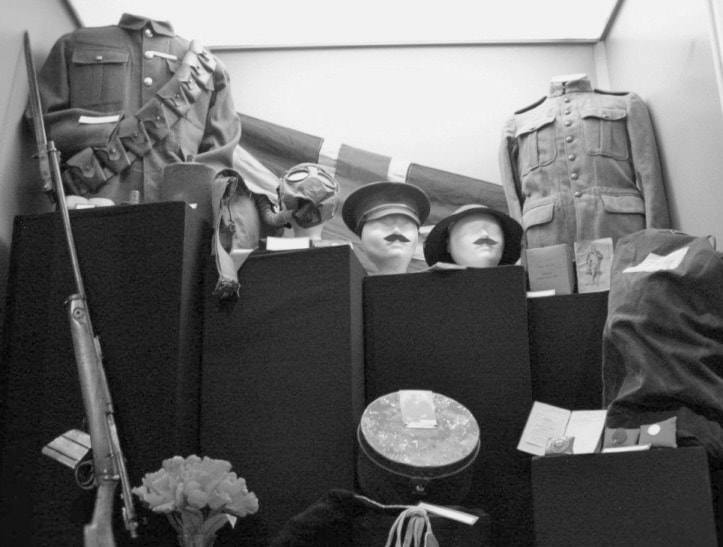Sandy, Melissa, and Caitlin, your congenial hosts at the Fort Ostell Museum have just completed a vivid and realistic display that salutes the proud and strong involvement of our Canadian Armed Forces’ men and women in the First World War. WWI, or the Great War, which was waged from July 28, 1914 to November 11, 1918 was a global war centered in Europe, and will always be known as one of the deadliest conflicts in history. This massive confrontation, all fought hand to hand in the trenches and rugged countryside, will never be forgotten, and would pave the way for revolutions and major political changes that would be felt around the world, long into the future.
If you visit our Royal Canadian Legion Branch #66 in Ponoka, you are welcome to browse through the clubrooms and view the magnificent scrolls, pictures and memorabilia that honour our veterans and our soldiers of past and present from town and districts, who have bravely served and carried the Canadian colors in over a century of wars and peace keeping efforts, both at home and abroad. A total of 154 locals served in World War I, in which 70 million combatants were involved and nine million personnel were killed in the heat of the battle, including 60,000 Canadians.
The colorful new display at the Fort Ostell Museum features many of the uniforms of our Canadian soldiers and nurses, their weapons and ammunition, survival gear (including the ominous gas masks), their medals, as well as pictures and amazing accounts of the horrific battles in which they were front and centre. The Canadian victory at Vimy Ridge was considered as a defining moment for our nation, when our armed forces emerged from under the shadow of Britain and felt capable of greatness. The key to their victory would be a devastating and well organized artillery barrage, which would not only isolate the enemy trenches, but also provide a moving wall of high explosives and shrapnel to force the Germans to stay in their deep dugouts and away from their powerful weapons. One of the most successful military events in our colorful and rugged history would unfold when attacking for the first time; the four Canadian divisions stormed the ridge at 5:30 a.m. on April 9, 1917 with more than 15,000 soldiers and overran the Germans along the front. Hill 145, the highest and most important feature of Vimy Ridge was captured, and a glorious final victory was delivered after just three more days of battle. The Canadian operation had defeated the odds and achieved great success, even when the larger French and British offences had failed, but it would come at a great cost, with 3598 of our soldiers killed and 7000 wounded. And then there were many other battles in which our Canadian military personnel were engaged, and all are featured at the amazing Fort Ostell Museum display.
● In a muddy corner of Belgium, Canadian soldiers overcame unimaginable hardships to capture the ruined and muddy Village of Passchendaele in 1917. It would be the ‘City of Winnipeg 27th Division’ that would lead the final charge on November 6, but once again the victory would come at a terrible price, with over 4000 Canadians dead and 12,000 wounded. It was after Passchendaele that the success of the Canadian lads had earned them the reputation as the best offensive fighting force on the Western front.
● The Battle of Flers-Courcelette was a small part of the Battle of the Somme, but was different than any other confrontations because of the new innovations that had been developed, including the creeping artillery barrage and the use of tanks in combat. The village was finally secured and held, but only after a strong German attack had caused a brief retreat, after which the Canadian 63rd Division were called in as reinforcements to secure the victory, but with high casualties.
● At the Battle of Mount Sorel in the Ypres salient, the third Canadian Division was the target of a crushing German bombardment, whose goal it was to secure the last remaining high ground still in the British hands. Despite losing ground and position, the Canadians launched a counter attack, and eventually achieved victory on the third and final operation, but at a heavy cost of 8000 casualties.
● Other crucial WWI battles and bombardments where our Canadian soldiers were heavily involved included: the Battle of Langemarck, the Battle of Amiens (which was the beginning of the end for the German armies), the Battle of Drocourt-Queant on September 2, 1918 (where the Canadian Division attacked the DQ line supported by tanks and aircraft during the 100 Days Offensive, which was the final period of the war), The Battle of Canal du Nords, and the Battle of Courtrai, which culminated the ongoing advancement of the front lines of our Allied army, while capturing many cities along the way, and would finally achieve a tremendously hard fought, but superb victory.
Every year Canadians honour our veterans and their families during the week of November 5 to the 11 (Veteran’s Week), remembering those who fought to the end, some making the ultimate sacrifice while defending our nation’s interests at home and abroad.
The Fort Ostell Museum will celebrate Heritage Weekend with their annual Heritage High Tea on Saturday-August 2 from 1 p.m. to 5 p.m., which will also be a great opportunity for visitors to see the new World War I display as well as all the other artifacts and treasures dedicated to the long and colorful history of Ponoka and districts.
